
Apiaceae or Umbelliferae is a family of mostly aromatic flowering plants named after the type genus Apium and commonly known as the celery, carrot or parsley family, or simply as umbellifers. It is the 16th-largest family of flowering plants, with more than 3,700 species in 434 genera including such well-known and economically important plants as ajwain, angelica, anise, asafoetida, caraway, carrot, celery, chervil, coriander, cumin, dill, fennel, lovage, cow parsley, parsley, parsnip and sea holly, as well as silphium, a plant whose identity is unclear and which may be extinct.

Brassicaceae or Cruciferae is a medium-sized and economically important family of flowering plants commonly known as the mustards, the crucifers, or the cabbage family. Most are herbaceous plants, while some are shrubs. The leaves are simple, lack stipules, and appear alternately on stems or in rosettes. The inflorescences are terminal and lack bracts. The flowers have four free sepals, four free alternating petals, two shorter free stamens and four longer free stamens. The fruit has seeds in rows, divided by a thin wall.

The stamen is the pollen-producing reproductive organ of a flower. Collectively the stamens form the androecium.

The Crassulaceae, also known as the stonecrop family or the orpine family, are a diverse family of dicotyledon flowering plants characterized by succulent leaves and a unique form of photosynthesis, known as Crassulacean acid metabolism (CAM). Flowers generally have five floral parts. Crassulaceae are usually herbaceous but there are some subshrubs, and relatively few treelike or aquatic plants. Crassulaceae are a medium size monophyletic family in the core eudicots, among the order Saxifragales, whose diversity has made infrafamilial classification very difficult. The family includes approximately 1,400 species and 34–35 genera, depending on the circumscription of the genus Sedum, and distributed over three subfamilies. Members of the Crassulaceae are found worldwide, but mostly in the Northern Hemisphere and southern Africa, typically in dry and/or cold areas where water may be scarce, although a few are aquatic.
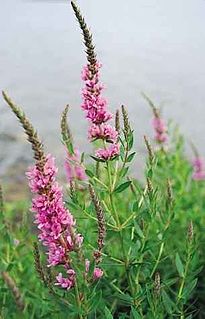
Lythraceae is a family of flowering plants, including 32 genera, with about 620 species of herbs, shrubs, and trees. The larger genera include Cuphea, Lagerstroemia (56), Nesaea (50), Rotala (45), and Lythrum (35). It also includes the pomegranate and the water caltrop. Lythraceae has a worldwide distribution, with most species in the tropics, but ranging into temperate climate regions as well.
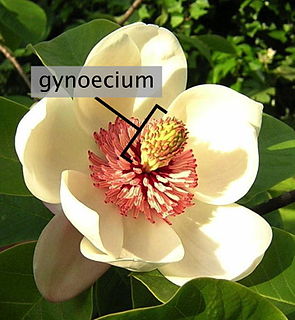
Gynoecium is most commonly used as a collective term for the parts of a flower that produce ovules and ultimately develop into the fruit and seeds. The gynoecium is the innermost whorl of a flower; it consists of pistils and is typically surrounded by the pollen-producing reproductive organs, the stamens, collectively called the androecium. The gynoecium is often referred to as the "female" portion of the flower, although rather than directly producing female gametes, the gynoecium produces megaspores, each of which develops into a female gametophyte which then produces egg cells.

Illiciaceae A.C.Sm. was a family of flowering plants recognized in a number of systems of plant taxonomy. The Illiciaceae is not recognized as a distinct family by the APG III system of plant taxonomy, the most well accepted system in use today.

Sabiaceae is a family of flowering plants that were placed in the order Proteales according to the APG IV system. It comprises three genera, Meliosma, Ophiocaryon and Sabia, with 66 known species, native to tropical to warm temperate regions of southern Asia and the Americas. The family has also been called Meliosmaceae Endl., 1841, nom. rej.
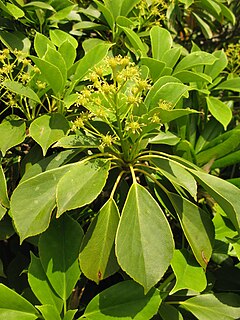
Trochodendraceae is the only family of flowering plants in the order Trochodendrales. It comprises two extant genera, each with a single species along with up to five additional extinct genera and a number of extinct species. The living species are native to south east Asia. The two living species both have secondary xylem without vessel elements, which is quite rare in angiosperms. As the vessel-free wood suggests primitiveness, these two species have attracted much taxonomic attention.

Eupomatia is a genus of three flowering shrub species of the Australian continent, constituting the only genus in the ancient family Eupomatiaceae. The Eupomatiaceae have been recognised by most taxonomists and classified in the plant order Magnoliales. The three species of shrubs or small trees grow naturally in the rainforests and humid eucalypt forests of eastern Australia and New Guinea. The type species Eupomatia laurina was described in 1814 by Robert Brown.

Calyceraceae is a plant family in the order Asterales. The natural distribution of the about sixty species belonging to this family is restricted to the southern half of South America. The species of the family resemble both the family Asteraceae and the Dipsacaceae.

Hygrophila, commonly known as swampweeds, is a genus of flowering plants in the acanthus family, Acanthaceae. There are about 80 to 100 species, of which many are aquatic plants. The genus is distributed across the tropical and subtropical world. It is one of only two genera in its family that contains aquatic plants, the other being Justicia. The genus is treated in the tribe Hygrophileae, which is noted as being in need of revision at the genus level, meaning the current taxonomic boundaries of Hygrophila are likely to change in the future.

The Cleomaceae are a small family of flowering plants in the order Brassicales, comprising about 300 species in 10 genera, or about 150 species in 17 genera. These genera were previously included in the family Capparaceae, but were raised to a distinct family when DNA evidence suggested the genera included in it are more closely related to the Brassicaceae than they are to the Capparaceae. The APG II system allows for Cleomaceae to be included in Brassicaceae.
This page provides a glossary of plant morphology. Botanists and other biologists who study plant morphology use a number of different terms to classify and identify plant organs and parts that can be observed using no more than a handheld magnifying lens. This page provides help in understanding the numerous other pages describing plants by their various taxa. The accompanying page—Plant morphology—provides an overview of the science of the external form of plants. There is also an alphabetical list: Glossary of botanical terms. In contrast, this page deals with botanical terms in a systematic manner, with some illustrations, and organized by plant anatomy and function in plant physiology.

Sarcomelicope is a genus of about ten species of flowering plants in the family Rutaceae that are endemic to the South Pacific.
This glossary of botanical terms is a list of definitions of terms and concepts relevant to botany and plants in general. Terms of plant morphology are included here as well as at the more specific Glossary of plant morphology and Glossary of leaf morphology. For other related terms, see Glossary of phytopathology and List of Latin and Greek words commonly used in systematic names.

Paeonia ludlowii, is a medium high, deciduous shrub, belonging to the peonies, that is endemic to southeast Tibet. In Tibet it is known as lumaidao meaning "God’s flower". The vernacular name in Chinese is 大花黄牡丹 meaning "big yellow-flowered peony". In English it is sometimes called Tibetan tree peony or Ludlow's tree peony. It has pure yellow, slightly nodding, bowl-shaped flowers, and large, twice compounded, light green leaves.

Galeopsis bifida is an annual plant native to Europe and Asia but now found in Canada and the northeastern, midwestern parts of the United States. It has many common names such as bifid hemp-nettle, split-lip hemp-nettle, common hemp-nettle, and large-flowered hemp-nettle. The genus name means weasel-like, referring to the corolla of the flower. It is often confused with other species of Lamiaceae such as Mentha arvensis, Dracocephalum parviflorum and Stachys pilosa.
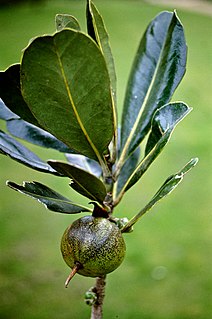
Strasburgeria robusta is an evergreen tree with large toothed leaves and large but rather inconspicuous, single, pendulant flowers in a gloomy colorscheme of yellowish with brown markings, with about ten sepals, five petals, ten stamens, a very distinct circular nectar gland with radiating spikes and rather large globular fruits with a long persistent style, with a scent reminiscent of apples, which is endemic to New Caledonia. It is the only recognized species of the genus Strasburgeria.
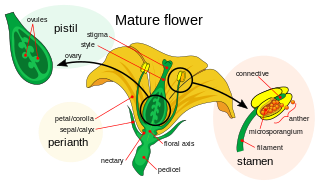
In botany, floral morphology is the study of the diversity of forms and structures presented by the flower, which, by definition, is a branch of limited growth that bears the modified leaves responsible for reproduction and protection of the gametes, called floral pieces.

















